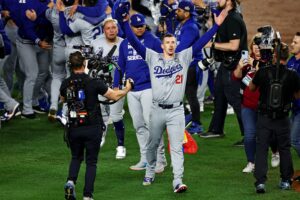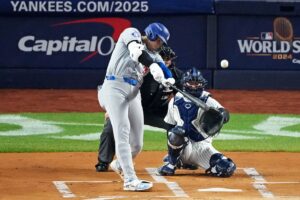The Washington Nationals Starting Rotation is Deeper than Years Past
From their 98-win season in 2012 to their magical World Series run in 2019, the Washington Nationals have been built on their starting rotation. They signed Max Scherzer to a mammoth seven-year, $210 million contract and chose to re-sign World Series MVP Stephen Strasburg over star third baseman Anthony Rendon. The Nationals have invested $595 million in their top-three starters, Scherzer, Strasburg, and Patrick Corbin. This has been at expense of stardom in the batting lineup, as the aforementioned Anthony Rendon and Bryce Harper departed in free agency.
In 2019, the Nationals led the majors with a 3.53 starting rotation ERA. The rotation was critical in the postseason, both in starting and relief roles, as Strasburg went 5-0 with a 1.98 ERA and 47 strikeouts in 36 and one third innings. However, last season, the Washington Nationals foundation faltered. Strasburg missed the majority of the season with carpal tunnel neuritis and Corbin and Scherzer were not at their best. Corbin led the NL in hits allowed, 85, and had a 1.57 WHIP, while Scherzer posted his highest ERA since 2012, 3.74, and allowed more hits than innings pitched. The backend of the rotation wasn’t any better for Washington. Anibal Sanchez posted a 6.62 ERA and Austin Voth and Erick Fedde remained inconsistent, although they both finished the season strong.
With Joe Ross returning and a farm system whose top-ten prospects are all pitchers according to MLB.com, the Nationals rotation looks to have more depth than before and the potential to find another top-tier starting pitcher.
The “Big Three” Should Return to Form
The Washington Nationals will be as good as their top three starting pitchers in 2020. If they pitch similar to the 2019 season, the Nationals will be in contention for the NL East, but another 2020 season could have Washington under .500 once again. However, the struggles in 2020 may be due to the odd scheduling, limited spring training, and the injury to Strasburg. Scherzer is entering his age 36 season, but maintained his velocity last season. Although his starts where fans could count on four no-hit innings are of the past, Scherzer should be an excellent ace next season.
Patrick Corbin saw a slight dip in fastball velocity last season, falling 1.6 miles per hour. But, he should lower his 4.66 ERA, his highest since 2016, and revert back more towards his 2019 numbers, when he pitched to a 3.25 ERA. The biggest question for the Nationals is the health of Stephen Strasburg. According to manager Davey Martinez, Strasburg, who is entering the second year of his seven-year contract, is having a “regular” offseason, boding well for his health. With Scherzer’s age, Strasburg may need to step up this season and be in Cy Young contention and, most importantly, remain healthy.
The Experienced, but Young Pitchers
Joe Ross opted out of the 2020 season and looks to be returning this season. Towards the end of the 2019 season, Ross showed flashes of his pre-Tommy John self, regaining his excellent sinker. In his last eight starts, Ross posted a 2.75 ERA and the Nationals went 7-1 in his starts. Ross has the highest upside out of Voth and Fedde as he was excellent in his first two seasons in the majors, before undergoing Tommy John surgery. Martinez also had high expectations for the 27-year old right-hander.
Other than Ross, Austin Voth could rebound from a tough 2020 campaign. His ERA increased by 3.04 from 2019 but he allowed nine more home runs in 2020. Voth got into a small rhythm in his last three starts, allowing just one run in two of them. Fedde is another option for the Nationals. He had a 4.29 ERA last season, but he hasn’t been consistently going deep into games and possessed a 1.27 strikeout to walk ratio. He went five or more innings in six out of his last seven starts after failing to do so in his first four.
Out of these three options, the Nationals should be able to have at least one solid backend piece.
The “X-Factors”: High Upside, but Raw
After the Nationals traded Lucas Giolito, Reynaldo Lopez, Dane Dunning, and Jesus Luzardo, they lacked upside for starting pitching in the farm system. However, this could change this season. Jackson Rutledge, Cade Cavalli, and Seth Romero could all find themselves contributing. In the minor leagues, Rutledge has a 3.13 ERA and a 0.99 WHIP. Cavalli was Washington’s first-round draft pick this past season and is seen as a fast-riser in the farm system.
Despite the lackluster statistics, Seth Romero showed promise with a nasty slider in his short stint in the major leagues out of the bullpen. Romero had never pitched above Low Single-A prior to his MLB debut and his season ended after he fractured his non-throwing hand. The Nationals also have young pitchers like Cole Henry, Tim Cate, and Andry Lara in the farm system.
Heading into 2021
While Washington has major question marks in their lineup heading into 2021, the pitching depth seems to be one of the best in recent memory. Washington could use a proven backend starter, but if Joe Ross can return to form, they should have one of the best top four arms in the major leagues. But, this is all dependent on the health and performance of their “big three”: Scherzer, Strasburg, and Corbin. If this were to occur, the Nationals should be in playoff contention once again in 2021.
Main Image
Embed from Getty Images






